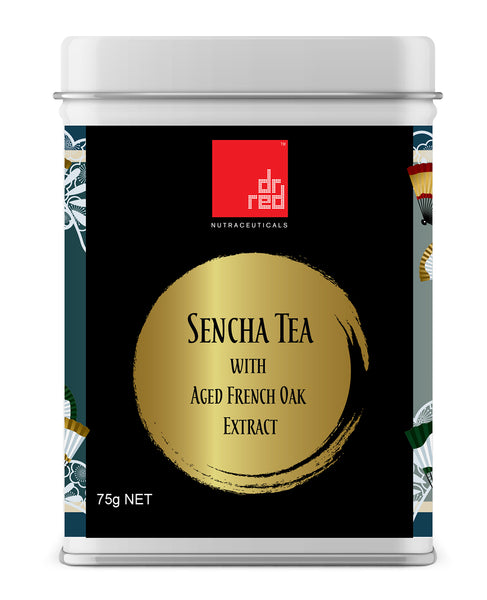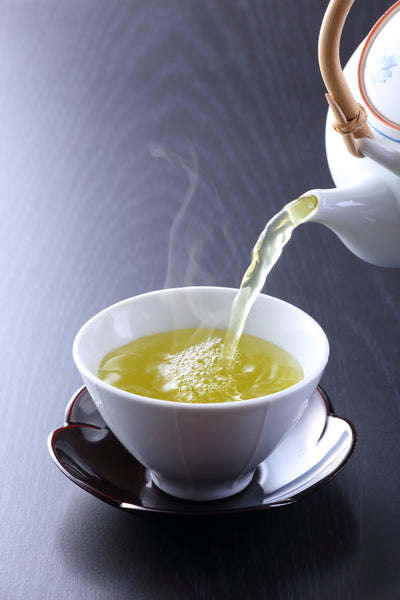Sencha Tea with Aged French Oak Extract
Introducing……….
Dr Red’s Sencha Tea with Aged French Oak Extract.
Made from Australian grown green tea, Sencha (sen-cha) translate as infused tea with “Sen” meaning to infuse and cha meaning tea. To this wonderfully vegetal, grassy tea we have added out Aged French oak extract to create not only a wellness tea but one which can provide a pick me up to your busy day.
What makes Sencha tea special?
Made from small-leaf Camellia sinesis bushes, Japanese sencha is a steamed, high-quality green tea variety. Do not confuse it with matcha – while matcha is grown under the shade, sencha green tea, albeit non-fermented as well, grows under full sunlight. What's more, matcha tea is often available as a green tea powder, while sencha is made using whole leaves.
The plants' top leaves and buds are crucial for brewing Sencha tea. After harvesting and during processing, the leaves are rolled into a needle-like shape before being steamed. Afterwards, the leaves are dried, sorted and then blended.
Sencha leaf tea comes in different varieties and boast of different colors. Some appear as pale green, while others are a bright, greenish yellow. For example, asamushi, a lightly steamed sencha, is very pale and has a light, delicate taste. Deep-steamed sencha, or fukamushi, has a more pronounced color and a bolder taste.
Each tea leaf is packed with many nutrients and a great aroma, ready to be infused whenever you need a nice cup of tea. This tea stands well on its own or is at the base of dozens of green tea blends.
Sencha is a tea that you can drink and enjoy every day and reap a world of health benefits at the same time.
Japenese Style Green tea Versus Chinese Style Green Tea
Chinese green tea and Japanese green tea both come from the same plant: Camellia Sinensis. However in many ways the similarities stop there. From when and how they're processed to the benefits they serve, Chinese green tea and Japanese green tea differ.
Green tea originated in China some 5,000 years ago with the first documents use of it appearing in 8thcentury in the book “The Classic of Tea” by Chinese write Yu Lu . In about 800 A.D., green tea expanded outside of China to other parts of Asia, where in Japan it was believed to have been brought back from China by Japanese Buddhist monks.
Where Chinese green tea leaves are processed by hand and can be sculpted into many shapes such as rolled balls, twisted into spirals and smoothed into swords, Japanese style teas are processed by machines ad is either pulverised into powder such as matcha tea or rolled into uniform needle shapes called Sencha. Although it makes Japanese style green tea less artful, it does not detract from the experience and tea culture created in Japan.
Unlike Chinese green teas that are pan-fried, the Japanese developed a technique of steaming the tea leaves to stop oxidation. This helped to preserve both the deep green color and astringent flavor that is unique to Japanese tea leaves. After being rolled, shaped and dried the sencha leaves obtain their unique flat needle shape and are then ready to be sorted into groups according to their quality.
There is at least minor consensus on a particular distinction of flavor between the two types of green tea. Chinese green tea and Japanese green tea are processed differently. In the processing of Chinese green tea, the leaves become slightly fermented. This is because in processing Chinese green tea the leaves are stored and then pan-fried whereas in Japanese green tea the leaves are steamed immediately after being picked. The storing of tea leaves before processing can produce fermentation that pan-frying alone cannot remove. The processing of tea leaves immediately after being picked, by contrast, precludes the fermentation process from initiating, while steaming would eliminate any anomalous fermentation that may occur preceding this step. For some people, this fermentation produces a slightly tart or sour flavor they may find undesirable. Japanese green tea leaves are not fermented when processed and therefore do not contain this subtle, potentially unwanted, additional flavor. Instead Japanese green tea tends to taste sweeter than Chinese green tea. (Contrarily, Japanese green tea also contains more chlorophyll, which some green tea drinkers find too "grassy" for their tastes.)
Japanese green tea reportedly contains 60 percent antioxidants compared with 12 to 16 percent for Chinese green tea. A study published in the September 2003 edition of "Journal of Chromatography" reports that the EGCG value of matcha is 137 times greater than that of China Green Tips green tea.
Comparing the two styles of green tea most known across the world gives you some indication of the science and long history of the culture of green tea in Asia. Which is best for you is completely up to your own individual taste.
Brewing Sencha Tea
1 - Add Tea to TeapotOne teaspoonful per cup is sufficient . This is approximately about a rounded teaspoon. However, you may adjust the amount depending on your own taste.
2 - Add Near-boiling Water to each cup and allow to cool for two minutes
By pouring the water into the cups, you are preheating the cups as well as having the correct amount of water for the cups you are preparing. Water should be around 80 C for best results.
3 - Pour the water from the cups into the teapot
Add the water from the cups to the teapot close the lid of the teapot. Let the tea brew for 1- 2 minutes. You may adjust the time for what suits your palate best. DO NOT stir, shake or mix the tea while brewing.
4 - Serve and Enjoy!
Pour small amounts of tea into each cup at a time, and go around until the very last drop is poured. Japanese firmly believe that the last drop of tea determines its taste as a whole!
You can add hot water again to the teapot for a second, or even a third brewing. Open up the teapot between brewing to allow the hot air to escape and cool down the remains tea in the pot before adding more water. The brewing time will need to be reduced to half of original brewing time.









